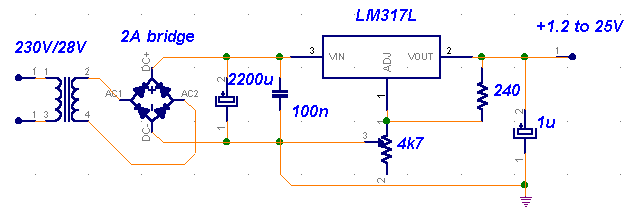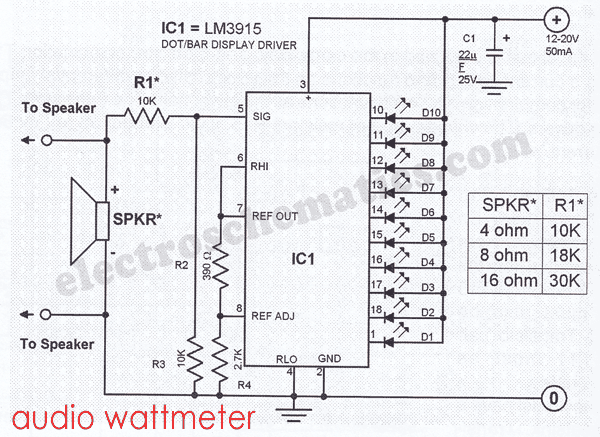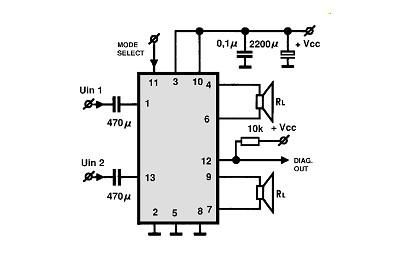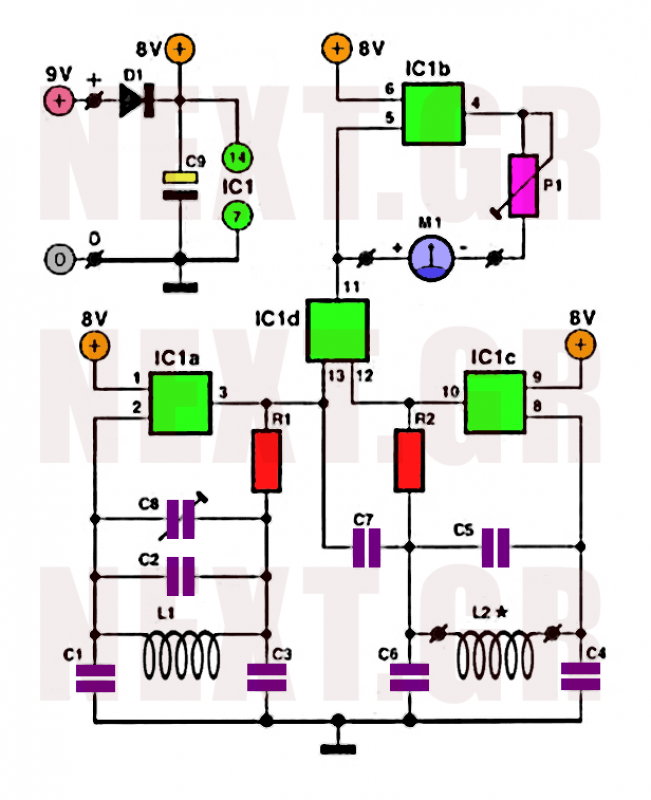
PGA202 offset voltage correction circuit

The PGA202 offset voltage correction circuit is designed to correct both input and output offset voltages. There are four different gain settings for the PGA202, which result in slight variations in input offset voltage. A 50k potentiometer is used for adjusting the input offset voltage, while a 10k potentiometer is employed for calibrating the output offset voltage. The circuit includes an OPA602 operational amplifier configured as a voltage follower, providing low resistance output at pin 4. For adjustment, a voltmeter is connected to pin 12, and pins 7 and 8 of the PGA202 are shorted to set VIN to 0. The 50k and 10k potentiometers are then adjusted to achieve a zero reading on the voltmeter.
The PGA202 offset voltage correction circuit utilizes a precision instrumentation amplifier, the PGA202, which is capable of providing variable gain settings to accommodate a range of applications. The circuit's design addresses the inherent input and output offset voltages that can affect the accuracy of measurements in sensitive electronic systems.
The gain settings of the PGA202 can be configured through external resistors, allowing for flexibility in signal amplification. The presence of a 50k potentiometer for input offset voltage correction enables fine-tuning of the input stage, ensuring that any offset introduced by the amplifier itself can be minimized. This is particularly crucial in applications where small signal detection is necessary, as even minor offsets can lead to significant errors in output readings.
The output offset voltage calibration is managed through a 10k potentiometer, which allows for adjustments after amplification. This stage is critical for achieving a zero output voltage when no input signal is present, thereby enhancing the overall accuracy of the system. The inclusion of the OPA602 operational amplifier as a voltage follower serves to buffer the output, minimizing the load on the PGA202 and ensuring that the output impedance remains low. This configuration is beneficial for interfacing with subsequent circuitry, as it prevents signal degradation.
For the adjustment process, the connection of a voltmeter to pin 12 provides a direct means to monitor the output voltage. By shorting pins 7 and 8, the input voltage (VIN) is effectively set to zero, establishing a baseline for calibration. The iterative adjustment of the 50k and 10k potentiometers allows the user to achieve a precise zero indication on the voltmeter, confirming that the offset correction has been successfully implemented.
Overall, this circuit exemplifies a well-engineered solution for offset voltage correction, utilizing common electronic components to achieve high precision in measurement and amplification tasks. The careful selection of potentiometer values and the use of a voltage follower ensure that the circuit remains adaptable to various operational conditions while maintaining accuracy. As shown for the PGA202 offset voltage correction circuit. PGA202 offset voltage correction circuits for input offset voltage and output offset voltage is corrected. Since ther e are four kinds PGA202 gain, input offset voltage at different gain slightly different, 50k potentiometer for correcting the input offset voltage; output offset voltage using 10k potentiometer calibration. OPA602 op amp voltage follower composition, low resistance output to 4 feet. Adjustment: at the output connected to a voltmeter 12 feet, 7-8 feet short PGA202 make VIN 0, respectively, and repeatedly adjust 50k 10k potentiometer, so that the output voltage meter to zero indication.
The PGA202 offset voltage correction circuit utilizes a precision instrumentation amplifier, the PGA202, which is capable of providing variable gain settings to accommodate a range of applications. The circuit's design addresses the inherent input and output offset voltages that can affect the accuracy of measurements in sensitive electronic systems.
The gain settings of the PGA202 can be configured through external resistors, allowing for flexibility in signal amplification. The presence of a 50k potentiometer for input offset voltage correction enables fine-tuning of the input stage, ensuring that any offset introduced by the amplifier itself can be minimized. This is particularly crucial in applications where small signal detection is necessary, as even minor offsets can lead to significant errors in output readings.
The output offset voltage calibration is managed through a 10k potentiometer, which allows for adjustments after amplification. This stage is critical for achieving a zero output voltage when no input signal is present, thereby enhancing the overall accuracy of the system. The inclusion of the OPA602 operational amplifier as a voltage follower serves to buffer the output, minimizing the load on the PGA202 and ensuring that the output impedance remains low. This configuration is beneficial for interfacing with subsequent circuitry, as it prevents signal degradation.
For the adjustment process, the connection of a voltmeter to pin 12 provides a direct means to monitor the output voltage. By shorting pins 7 and 8, the input voltage (VIN) is effectively set to zero, establishing a baseline for calibration. The iterative adjustment of the 50k and 10k potentiometers allows the user to achieve a precise zero indication on the voltmeter, confirming that the offset correction has been successfully implemented.
Overall, this circuit exemplifies a well-engineered solution for offset voltage correction, utilizing common electronic components to achieve high precision in measurement and amplification tasks. The careful selection of potentiometer values and the use of a voltage follower ensure that the circuit remains adaptable to various operational conditions while maintaining accuracy. As shown for the PGA202 offset voltage correction circuit. PGA202 offset voltage correction circuits for input offset voltage and output offset voltage is corrected. Since ther e are four kinds PGA202 gain, input offset voltage at different gain slightly different, 50k potentiometer for correcting the input offset voltage; output offset voltage using 10k potentiometer calibration. OPA602 op amp voltage follower composition, low resistance output to 4 feet. Adjustment: at the output connected to a voltmeter 12 feet, 7-8 feet short PGA202 make VIN 0, respectively, and repeatedly adjust 50k 10k potentiometer, so that the output voltage meter to zero indication.





